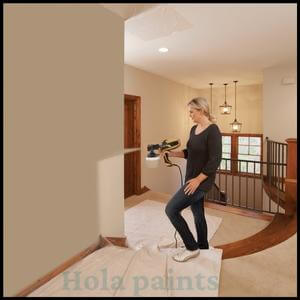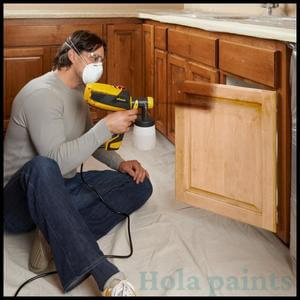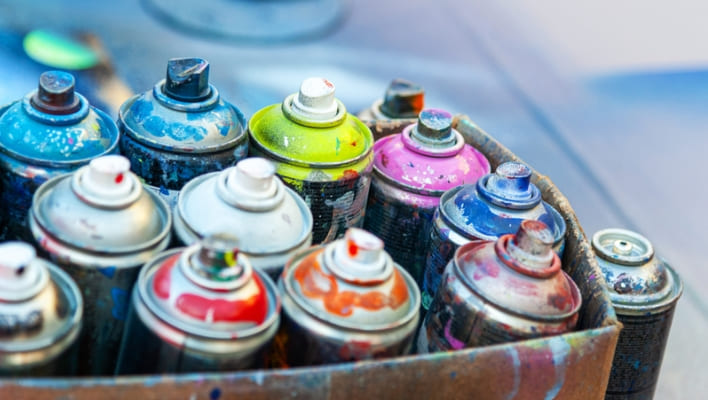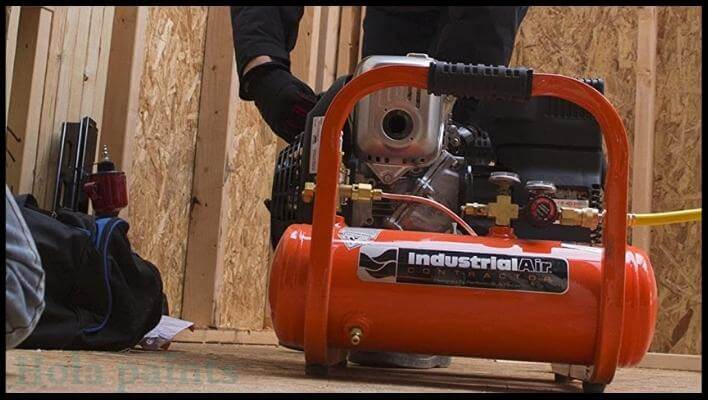Spray paint indoors is a DIY and most straightforward task, but only if you act according to the right procedure. I’m saying it is a DIY task because it’s not too risky and does not require you to be an expert painting professional. You are free from depending on outdoor weather conditions and many technical complications.
Before telling you about the right procedure, let me share my recent experience with spray paint inside. A client hired me for an indoor painting project; I inspected his home and gave him a quote. After the contract, I spent a whole day removing the old paint because I wanted to make every job a perfect job. I don’t skip even a single step. That’s why I have done dusting, scraping, and covering the light fixtures. It was a short project, but it took 3 days to complete. The purpose of sharing this story is that interior spray painting is easier, but you have to spend time to get rich painting results.
Table of Contents
- Is It Safe To Spray Paint Indoors?
- How To Spray Paint Indoors: Instructions
- Important Supplies For Spray painting indoors
- Step 1: Prepare The Surface
- Step 2: Additional Surface Cleaning
- Step 3: Apply The Primer
- Step 4: Prepare The Paint
- Step 5: Apply The Paint Via Sprayer
- Step 6: Seal The Spray Paint indoors (Optional)
- Spray Painting Inside Apartment
- Spray Paint Indoors Tips
- Rust-Oleum Spray Paint Indoors
- Can I Spray Paint Indoors Without A Mask?
- FAQs On Spray painting Indoors
- Is it safe to use spray paint indoors?
- Can spray paint fumes be harmful?
- How do you ventilate a room for spray painting?
- Is Rust-Oleum spray paint safe indoors?
- How to spray paint indoors without overspray?
- Final Words On How to Spray paint Indoors
Is It Safe To Spray Paint Indoors?
In particular, we can say that spray paint indoors might be dangerous for many reasons. First, if you don’t apply it correctly and follow the primary safety precautions. Secondly, oil-based indoor paints are hazardous for sensitive skin, throat, nose, and lungs because of the high amount of toxicants. On the other hand, you are good to go with indoor paints after proper ventilation and wearing a face mask.
How To Spray Paint Indoors: Instructions

If you are willing to paint the home interior, you need to understand the authentic procedure for efficient results.
Remember that you need to have some preparation to perform the job as you want.
Let’s move on to the step-by-step guide on how do you spray paint indoors without making a mess.
Important Supplies For Spray painting indoors
Before starting, I have collected the following tools and materials. Depending on your expertise and needs, the number of supplies might vary.
- Paint bucket
- Painter’s Tape
- Dust containment poles
- Drop cloths
- A suitable paint sprayer for indoor projects
- Floor coverings
Step 1: Prepare The Surface
Preparation is the first step to get efficient and appropriate results. Removing old paint, cleaning the dust, dirt, and debris is important; therefore, I always start project from here. This step is very helpful in removing additional mold or mildew buildup. In my case, that location is the the basement area. I opened all the windows and ventilation to make it an open-air area. It will help to dry and prepare the surface well.
Step 2: Additional Surface Cleaning
Sometimes, the indoor surface gets peeled off, highly damaged, and open to fungus. It’s useless to apply the paint directly in such conditions. I recommend you cure all these problems using a scraper, vacuum, or other cleaning tools.
Step 3: Apply The Primer
Next, I started applying the primer using a brush or roller on the indoor surface. It makes the surface smooth and gives more adhesion to the paint when applied. I left the primer for a few hours to dry it thoroughly.
If you are stuck with primer selection, you can buy a suitable primer from well-known brands such as Rustoleum, Zinnser, and more. You should match your budget and other painting requirements.
Step 4: Prepare The Paint
Afterward, I prepared the paint according to the type you have purchased, i.e., oil-based or water-based paints. Always recognize that the paint should not be too thin or thick; otherwise, it will result in a poor finish.
Step 5: Apply The Paint Via Sprayer
Mostly people asked, How to use a paint sprayer indoors?

Usually, I held the Wagner 590 sprayer in my hands for interior painting projects. My first step was to test the consistency of paint in a paint sprayer before applying it indoors.
I started applying the paint indoors from one corner in thin layers as it will vanish all the imperfections.
Everyone should maintain a standard distance between the walls and tip of the sprayer and let it dry completely after the first coat.
Wait till the specified dry time of the paint and give a second coat to the paint. Don’t paint too fast or slow; balance the speed, and you are good to go.
Step 6: Seal The Spray Paint indoors (Optional)
Sealing the spray paint indoors adds an additional protective layer to the paint. It makes it stick long and protects it from any damage. The primary benefit is to save the paint from peeling off, flaking off, and fading off too quickly. I suggest not using the room or kitchen for about 8 hours after applying the sealant.
Spray Painting Inside Apartment

It’s effortless to spray paint inside an apartment. First, choose a location from where you will get started. I always suggest starting from any corner to get symmetry while painting. Make the sprayer ready by following a manual guide when setting the temperature. Cover the floor, light fixtures, and open all the ventilation. Start painting using a sprayer and apply a second coat if needed. Congrats! You have done spray painting an apartment accurately.
Spray Paint Indoors Tips
When you quickly want to upgrade your home or bedroom interior, go for spray painting. Undoubtedly, it’s the quickest and easiest way to revamp your home. However, you can make the overall procedure efficient and ideal if you follow the tips mentioned below:
- Always choose the right location to get rid of a mess.
- Take care of the ventilation as it will exhaust the extra paint, dirt, dust, and toxic fumes in the open air.
- Don’t miss the preparation work, as it’s necessary to pull out the residue, dirt, or dust.
- Always practice before painting on the walls to prevent overspray. Practice using drop cloth as you will need it throughout your project.
- Don’t spray paint indoors too fast. Apply two or more coats smoothly and adequately as patience creates the best results.
- Don’t trigger the sprayer in a random position. Always choose a pattern of your choice and follow it on the whole surface.
- Always permit the paint to dry completely before another coat. It prevents moisture and allows a beautiful paint finish.
- Always choose a user-friendly and environmentally friendly option for indoor painting.
Rust-Oleum Spray Paint Indoors
Rust-Oleum is a top-notch brand for manufacturing indoor paints. Keeping the user intentions and public demands, Rust-Oleum paint can now be spray painted indoors. Also, I tested Krylon Fusion spray paint for indoor painting because of its quick drying formula.
The other painting steps are the same, but you have to choose the right Rust-Oleum paint can size. For this, read the label carefully, check the specifications, match them with your requirements, and pick the right paint for your home interior.
Can I Spray Paint Indoors Without A Mask?
I never recommend you spray paint inside your home without wearing a quality mask. Yes, spray paint might be dangerous for you, and you might be caught by some severe lungs or breathing problem. Therefore, always wear it as a safety precaution. It helps protect you from many scent-free particles, toxic fumes, and harmful chemicals.
FAQs On Spray painting Indoors
Is it safe to use spray paint indoors?
Yes, there are no issues with using spray paint indoors. The key requirement is that you follow all the safety precautions and have proper arrangement of the ventilation.
Can spray paint fumes be harmful?
Yes, spray paint fumes can have short and long-term effects on lungs, breathing, and skin. They can cause eye stress, nose irritation, throat irritation, loss of coordination, nausea, headaches, and other health problems. Therefore, always spray paint indoors after wearing a face mask.
How do you ventilate a room for spray painting?
Spraying paint in a well-ventilated area is always recommended by professionals. You can make a space ventilated by opening the ventilation, windows, and doors. You can also run the exhaust fans to eliminate the toxic fumes while painting.
Is Rust-Oleum spray paint safe indoors?
Yes, Rust-Oleum spray paint is 100% safe and suitable for indoor painting. Nowadays, they manufacture less toxic paints having low VOCs. Not only on the walls, but they are also suitable for different surfaces such as Masonite, wood, drywall, cement, and metal.
How to spray paint indoors without overspray?
Overspray brings poor spots on the walls destroying the overall paint finish. To prevent overspray, press the trigger gently and spray from a specific distance. Furthermore, paint the whole surface gently at a constant speed and cover the unwanted areas properly.
Final Words On How to Spray paint Indoors
In conclusion, spray paint indoors is not a messy task if you are on the right way. You should follow each step mentioned in the guide to get an efficient output. To reduce overspray, you can use proper coverings, and spray gently. Congratulations! You have learnt the process of spray painting indoors without any trouble.

Martina Hitchcock
Martina Hitchcock is a versatile author with expertise in different fields. As a paint sprayer expert, she has in-depth knowledge of paint spraying techniques, tools, and equipment. Martina is also an experienced home remodeler who has worked on various projects, including kitchen and bathroom renovations, flooring installations, and room additions. Her knowledge of home improvement and remodeling is extensive, and she enjoys sharing her insights and tips with readers. You can follow her on Facebook.


